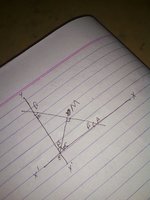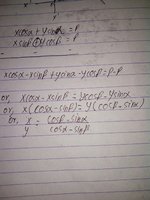I am a brawl guy
New member
- Joined
- Nov 26, 2019
- Messages
- 4
Ok!
So today I spend my whole day thinking about it:
We all know
Xcos(alpha)+ysin(alpha)=p ----equation (I)
right?
Then first look this:
 and say
and say
Can the :
Xcos(alpha)+ysin(alpha)=p
Be said as
X [OM]/[OA]+y [OM]/[OB]=P ?
IF YES GO TO NEXT STEP
IF NO REPly THE REASON
and in triangle OMA
sin(beta) = OM/OA WHICH IS ALSO EQUAL TO COS (ALPHA)
and in triangle OMB
Cos(beta) = OM/OB WHICH IS EQUAL TO SIN(ALPHA)
NOW SUBSTITUTE THE VALUES OF COS AND SIN ALPHAS TO SIN AND COS BETAS RESPECTIVELY
Then we get this:
Xsin(beta)+ycos(beta)=p ----equation(ii)
Now subtracting equation I and ii we will get this :
Now we know
As I have already said
Up
Sin(alpha) = cos(beta
And
Sin (beta) = cos (alpha)
So elemating or further calculating we get this:

WHICH IS MATHEMATICALLY IMPOSSIBLE
I can't figure out of I am wrong or the maths is wrong like 1=2
So today I spend my whole day thinking about it:
We all know
Xcos(alpha)+ysin(alpha)=p ----equation (I)
right?
Then first look this:
 and say
and sayCan the :
Xcos(alpha)+ysin(alpha)=p
Be said as
X [OM]/[OA]+y [OM]/[OB]=P ?
IF YES GO TO NEXT STEP
IF NO REPly THE REASON
and in triangle OMA
sin(beta) = OM/OA WHICH IS ALSO EQUAL TO COS (ALPHA)
and in triangle OMB
Cos(beta) = OM/OB WHICH IS EQUAL TO SIN(ALPHA)
NOW SUBSTITUTE THE VALUES OF COS AND SIN ALPHAS TO SIN AND COS BETAS RESPECTIVELY
Then we get this:
Xsin(beta)+ycos(beta)=p ----equation(ii)
Now subtracting equation I and ii we will get this :

Now we know
As I have already said
Up
Sin(alpha) = cos(beta
And
Sin (beta) = cos (alpha)
So elemating or further calculating we get this:

WHICH IS MATHEMATICALLY IMPOSSIBLE
I can't figure out of I am wrong or the maths is wrong like 1=2
